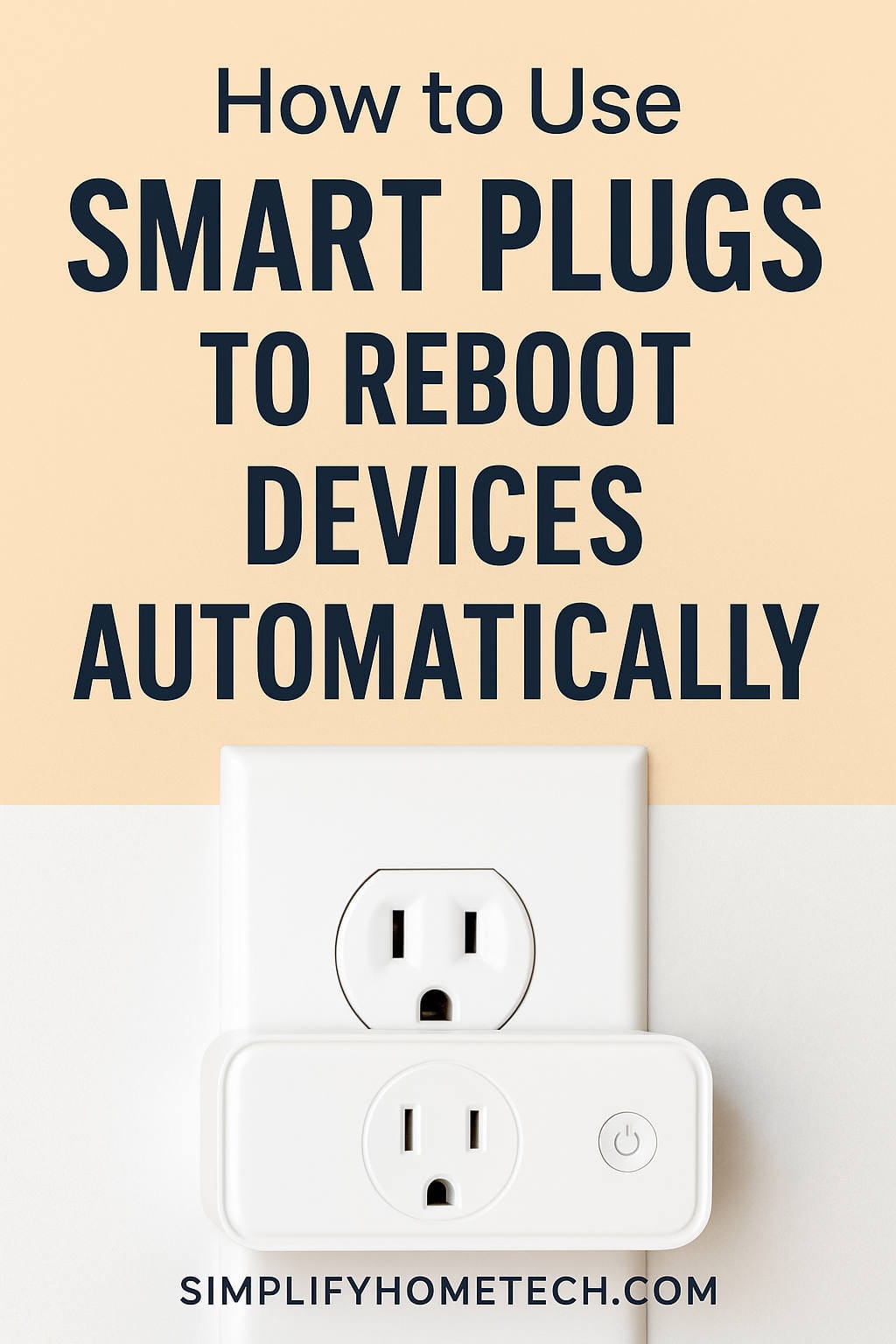Imagine this: your Wi-Fi suddenly cuts out in the middle of an important Zoom call. You rush over to the router, unplug it, wait 10 seconds, and plug it back in. It’s annoying — and worse, if you’re not home, it’s impossible to do. That’s where smart plugs come in, offering an elegant solution to a surprisingly common tech headache: automating the rebooting of electronic devices.
In this guide, you’ll learn everything there is to know about using smart plugs to automatically reboot devices like routers, modems, smart TVs, network switches, servers, and more — with zero tech jargon, no guesswork, and practical steps you can implement today.
What Exactly Are Smart Plugs?
At their core, smart plugs are Wi-Fi-connected power outlets. You plug them into a standard wall socket, then plug another device (like a lamp or router) into the smart plug. Using an app on your phone, or voice assistants like Alexa or Google Assistant, you can then turn that device on or off — from anywhere.
But here’s the secret sauce: most smart plugs come with scheduling and timer features, which means you can automate power cycles. And that opens up a world of possibilities for fixing problems before they start.
Why Would You Want to Reboot Devices Automatically?
If you’ve never thought about automating reboots, you’re not alone. But there’s a reason IT professionals and savvy homeowners swear by it.
1. Keeps Devices Running Smoothly
Modems and routers often get sluggish over time due to memory bloat, cache buildup, or software bugs. A nightly reboot clears things up and keeps your connection stable.
2. Minimizes Downtime
Automating reboots means your smart TV, server, or security camera is less likely to freeze, lag, or go offline unexpectedly.
3. Hands-Free Troubleshooting
Whether you’re at work or on vacation, a smart plug lets you reboot devices remotely — no need to physically unplug anything.
4. Reduces Maintenance Headaches
For people managing vacation homes, Airbnb properties, or remote offices, smart plugs make remote maintenance effortless.
Devices You Can Safely Reboot with Smart Plugs
While you should avoid using smart plugs on certain appliances like refrigerators or washing machines (for safety reasons), here are devices that are perfect for automated rebooting:
- Wi-Fi routers and modems
- Network switches
- Streaming devices (Roku, Apple TV, Fire TV)
- Smart TVs
- Game consoles
- Home servers (e.g., Plex, Raspberry Pi)
- VOIP phones
- Smart home hubs
- Security cameras and DVRs
- 3D printers
- Aquarium or hydroponic controllers
The golden rule is: if it turns back on automatically after losing power, it can likely be automated using a smart plug.
What You’ll Need to Get Started
Here’s a quick checklist before you dive in:
✅ A reliable smart plug (preferably one with scheduling and timer capabilities)
✅ The smart plug’s companion app (iOS or Android)
✅ A stable Wi-Fi connection
✅ The device you want to reboot (plugged into the smart plug)
✅ Optional: Voice assistant like Alexa or Google Assistant for routines
Step-by-Step: How to Use Smart Plugs to Reboot Devices Automatically
Let’s break it down in easy, actionable steps:
Step 1: Choose the Right Smart Plug
Not every smart plug is created equal — and choosing the wrong one can lead to frustration. You need a plug that’s dependable, easy to use, and responsive to scheduling.
Features to Look For:
- On/off scheduling
- Countdown timer
- Remote control via app
- Voice assistant compatibility (Alexa, Google Assistant, Siri)
- Offline memory (some can continue schedules without Wi-Fi)
- Good user reviews for reliability
Recommended Smart Plugs:
1. TP-Link Kasa Smart Plug EP10
- Excellent app, supports schedules and timers
- Easy integration with Alexa, Google
- Affordable and dependable
- Compact design
- Works well with Apple HomeKit, Alexa, and Google Assistant
- Budget-friendly
- Works with Alexa, Google, and HomeKit
- Good offline scheduling support
- Seamless Alexa experience
- Great for beginners
- Works with the Govee app, offers robust scheduling
- Optional energy monitoring
💡 Tip: Always check power ratings. Don’t exceed the smart plug’s maximum load (usually around 10-15 amps).
Step 2: Set Up Your Smart Plug
The initial setup is usually straightforward, and most smart plug apps walk you through it.
Here’s the typical setup flow:
- Plug in your smart plug to a wall outlet.
- Download the app associated with the plug (e.g., Kasa, Wemo, Smart Life, Govee).
- Create an account and follow in-app prompts to add the device.
- Connect it to your Wi-Fi network (usually 2.4 GHz is required).
- Name your plug something relevant like “Router Plug” or “Living Room Reboot.”
Now you can control your device manually from your smartphone — let’s automate it next.
Step 3: Automate the Reboot with Scheduling
This is where the magic happens. Most smart plug apps let you create detailed schedules — so you can set the plug to power off and then back on at specific times.
Example Reboot Schedule:
- Off at 3:00 AM
- On at 3:01 AM
That one-minute interval is enough to power cycle most devices safely.
How to Set This Up (Generic Steps):
- Open the smart plug app.
- Tap your device.
- Find the “Schedule” or “Timer” option.
- Create two entries:
- Turn Off at 3:00 AM.
- Turn On at 3:01 AM.
- Set it to repeat daily or weekly.
✅ Best Practice: Reboot routers and modems every 1–3 days for optimal performance.
Step 4: Use Countdown Timers for One-Time Reboots
Let’s say your router is acting up while you’re at work. With a smart plug, you can quickly reboot it remotely.
Here’s how:
- Open your smart plug app.
- Turn the plug off manually.
- Set a countdown timer for 1–2 minutes.
- The plug will automatically turn back on after the timer expires.
No more calling your spouse or roommate to unplug it for you!
Step 5: Create Voice-Controlled Reboot Routines (Alexa or Google Home)
Want to reboot a device by saying:
“Alexa, restart the internet”?
You can — using smart assistant routines.
How to Create a Routine in Alexa:
- Open the Alexa app.
- Tap “More” → “Routines” → “+”.
- Choose a trigger (e.g., voice command).
- Add the following actions:
- Turn off the smart plug
- Wait 1 minute
- Turn on the smart plug
You now have a voice-activated reboot switch. Google Home and Siri offer similar options.
Step 6: Advanced Automation with IFTTT or Home Assistant
If you’re into smart home ecosystems, you can go further with platforms like IFTTT or Home Assistant. This enables more complex automation based on triggers like:
- If device goes offline, then reboot via smart plug.
- If ping to a server fails, power cycle the plug.
Note: This setup requires basic scripting or third-party sensors — ideal for tech-savvy users or pros managing networks.
Pro Tips for Smooth Operation
To ensure your smart plug system runs like a dream, here are some key tips:
✅ Test Your Device’s Power-On Behavior
Unplug it manually. Does it power on when plugged back in? If yes, it’s safe to automate.
✅ Avoid Frequent Reboots
Automating nightly reboots is fine, but don’t overdo it. Stick to once a day or once every few days.
✅ Use a UPS for Mission-Critical Devices
To prevent power interruptions during outages, use an Uninterruptible Power Supply (UPS) along with your smart plug.
✅ Keep Plug Firmware and Apps Updated
Regular updates fix bugs and improve security.
✅ Label Your Devices Clearly
Especially helpful if you’re managing multiple smart plugs for different devices.
Real-Life Scenarios Where This Works Wonders
✅ At Home:
- Keep your router and modem refreshed for better internet.
- Prevent smart TV glitches or streaming app crashes.
- Reboot security cameras without needing to climb ladders or reach behind furniture.
✅ Remote Locations:
- Automate reboots at vacation homes to ensure internet stays live for smart devices.
- Manage power cycles at Airbnb properties or off-grid cabins remotely.
✅ Business Use:
- Maintain uptime for POS systems, small servers, or network switches.
- Manage digital signage or self-checkout kiosks in retail locations.
Common Problems and Troubleshooting
❌ Smart Plug Not Responding?
- Make sure it’s connected to a 2.4GHz Wi-Fi network.
- Try restarting your router (ironic, but helpful).
- Re-pair the smart plug with your app.
❌ Schedule Not Working?
- Double-check the AM/PM settings.
- Ensure time zone is set correctly in the app.
- Make sure firmware is updated.
❌ Device Didn’t Turn Back On?
- Your device might require a manual press or button after power loss.
- Solution: Check your device’s settings or upgrade to one that powers on automatically.
Frequently Asked Questions (FAQs)
Can smart plugs damage electronics by turning them off suddenly?
Generally, no — devices like routers or TVs are designed to handle power loss. However, avoid using smart plugs with appliances that may be sensitive to sudden shutdowns (e.g., computers not connected to UPS).
What happens if the smart plug loses Wi-Fi?
Most smart plugs won’t respond to app commands without Wi-Fi. However, many still follow scheduled tasks using internal timers.
Can I use a power strip with a smart plug to reboot multiple devices?
Yes, but be cautious not to exceed the plug’s power rating. For light-duty devices like a router + modem, it’s fine.
Is there any security risk in using smart plugs?
As with all IoT devices, use strong passwords, keep firmware updated, and buy from reputable brands to reduce risk.
How do I know if my device turns back on after power loss?
Test it: unplug your device, wait 10 seconds, plug it back in. If it powers on automatically, it’s safe to use with a smart plug.
Final Thoughts
In a world where our lives depend more than ever on stable internet and connected devices, automating simple tasks like power cycling becomes a smart move — literally.
Smart plugs don’t just add convenience — they save time, reduce stress, and prevent small problems from becoming major headaches. Whether you’re a tech enthusiast, a remote worker, or just someone who’s tired of rebooting the router manually, this small device can make a big difference.
Start small. Try automating just one reboot — like your Wi-Fi router — and see how much smoother things run. Once you see the results, you’ll wonder how you ever lived without it.

